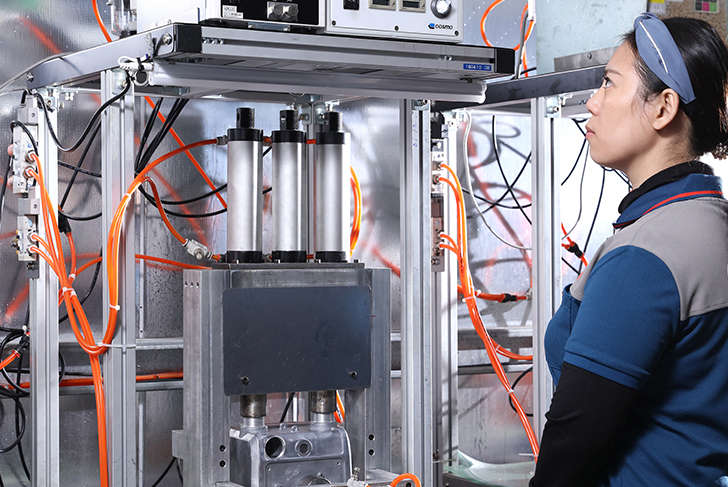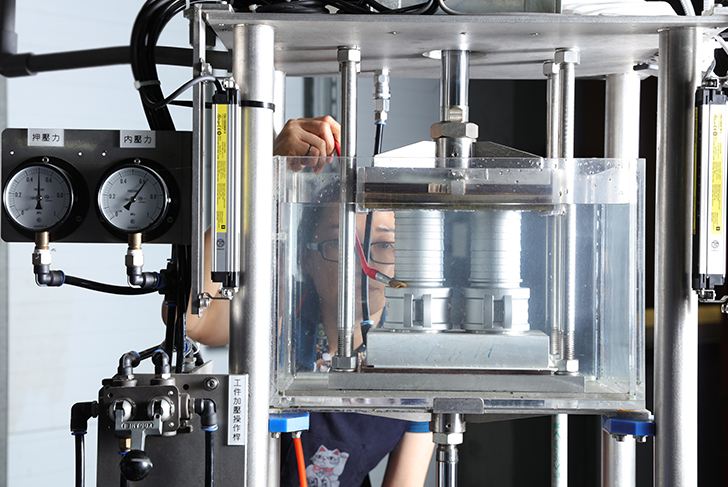- Home
- 100% Inspection for Airtight Testing
-
Engineering Feedback on Product Designs

-
Die-Casting Tooling Development and Maintenance

-
Die Casting

-
Deburring

-
CNC Machining

-
100% Inspection for Airtight Testing

-
Surface Treatment

-
Quality Inspection

-
Assembly Services

-
Packaging and Transportation

-
Dedicated Production Line Services

100% Inspection for Airtight Testing
Porosity Guarantee - Our Die Casting Quality Control Capability
Chi-Tai produces specific products that require leak testing to ensure their air-tightness, which may involve accommodating various substances such as natural gas, oil, or high-pressure air. To this end, Chi-Tai uses two main leak testing methods and provides additional options to meet the needs of specific products. Our testing methods include submersion bubble testing and pressure differential testing.
We have always been committed to providing high-quality die-casting products and employing the most advanced methods and technologies in the manufacturing process. The following section addresses how we face a key challenge in the die-casting process - porosity issues and ensure that our products are free of any porosity through comprehensive air-tightness testing.
Porosity is a defect that may occur during the die-casting process, and they are small air bubbles formed by the release of gas in the molten metal. Although these bubbles may be negligible, they may have adverse effects on the strength and durability of the product. We have therefore implemented a series of rigorous quality control measures to ensure that our shipped products are not affected by porosity.
1 Air Leakage Testing in Gas Product Line
For products that require an air-tight seal and must not allow for gas escape, we use differential pressure measurement to perform a full inspection and ensure that they meet the client's requirements. The maximum pressure can reach up to 250 PSI.
Differential Pressure Testing
Differential pressure decay leak testing is a method that uses traditional pressure decay parameters to measure pressure changes between the reference volume of air and the volume of the test piece in order to detect leaks. Unlike pressure decay leak testing, any change in pressure indicates the presence of a leak. This method is fast, reliable, and sensitive enough to detect even small leaks.
Differential mass flow leak testing, on the other hand, is similar to mass flow testing, but involves applying a reference volume that is similar or precisely equivalent to the design/volume of the test item. This eliminates certain additional flow behaviors that are unrelated to adiabatic conditions that are similar to leaks. During the test, air is replenished, and this flow measurement method makes the test pressure more stable and usually improves repeatability, depending on the application.
Conducting Leak Testing using COSMO Air-tightness Equipment Made in Japan
We will display the air-tightness data on the COSMO LS-R700 dashboard air-tightness gauge, which will simultaneously show the test pressure, pressure difference, leakage rate, and monitor the entire leakage testing process. The equipment has a high-precision leak detection data collection function, which ensures stable resolution of 0.1Pa and 1Pa when the pressure difference range is ±3000Pa or higher.
2 Air Leakage Testing in the Camlock Production Line
- Drilling holes to create a cam pin for a self-locking function.
- Testing for air leakage by ensuring a pressure difference of nearly 100 PSI.
- Soaking in 80°C water to prevent oxidation and eliminate water residue.
- Assembly process.
- Packaging for export purposes.

This is one of our dedicated specialized lines for one-stop production. We have supplied camlocks to OPW for over 10 years, and have manufactured over 2 million camlocks to date. Our production involves maintaining both quality control and assurance processes to deal with any aluminum part porosity problems in our products. Our aluminum camlock devices are known for their reliability, and we can guarantee that there will not be any air leakage after shipment.
Furthermore, we possess a high level of product development capabilities. We have developed 90 products for this client for over a period of 2 to 3 years.
Underwater bubble testing
Underwater bubble testing is the simplest and most cost-effective method for detecting and evaluating product leaks. Bubble leak testing is a method specifically designed to test whether parts are leaking.
The test involves immersing the air-filled part in a water tank and observing whether bubbles emerge from the part to identify leaks.

Compressed air is usually used in immersion testing, and parts are tested at various pressures. This method can immediately indicate the presence of small leaks and their location. Such tests are commonly used in the automotive, aerospace, electronics, medical, and fluid power industries.
